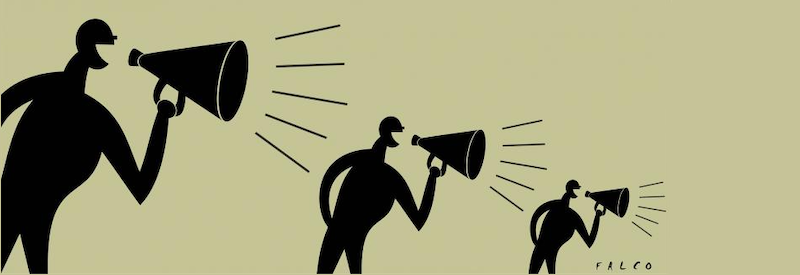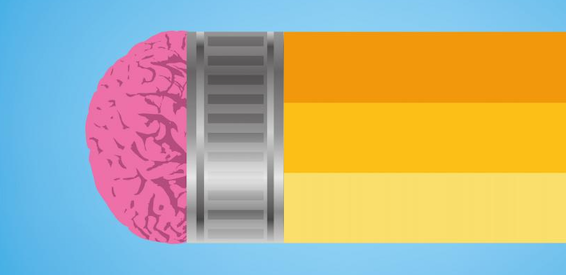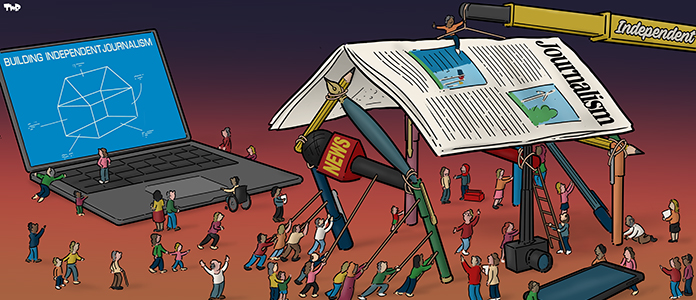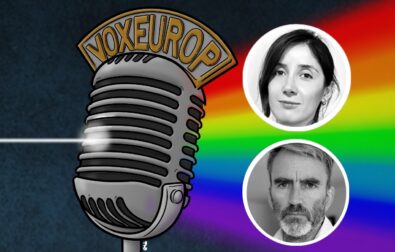Antek isn’t sure he should be talking to me at all. He’s told me so three times in half an hour. “You’re part of the system and I basically fuck the system”, he shrugs. Dressed in a black hoodie and sneakers, Antek doesn’t look like a hooligan. Skinny and pale, he lights one cigarette after another. He’s an anarchist and supports a radical leftist group called Antifa.
So why is he talking to me, a guy from the mainstream press? “See, you may think it’s just a game of demonstration and anti-demonstration. Sure, the happenings, protests, celebrity support and colour banners are important to educate the public. But the fascists don’t give a damn about banners. The only thing they can be afraid of is us. So let them hear about us”.
The so called Independence March, organised by rightwing and nationalist groups on 11 November, is to assume record-high proportions this year. The organisers hope of adding to the six ones in the event’s date two more to reflect the number of thousands of participants. But it’s not only them who’re mobilising. The march’s opponents have joined forces for a second year in a row and created the 11 November Coalition of leftist organisations. They say the nationalists are in fact fascists and the march has to be stopped. This year, for the first time, they are to be supported by large numbers of leftists and anarchists from all over Europe.
Anarchists of the world, unite
The Alliance’s website features leaflets in English and German, with Siempre Antifascista and Antifascist Left Berlin, German organisations considered extremist and violent, urging support for the anti-March action. In Berlin, Stuttgart, Rostock and several other German cities, anarchists have organised informational meetings under the slogan of “Let’s block a Nazi march in Warsaw”.
German leftist extremists are promising a repeat of Dresden, where their clashes with neo-Nazis on the anniversary of the Allied bombings of the city have become the largest street riots in Germany in years. A year ago, over 10,000 people stood on the anarchists’ side and several hundred were wounded on both sides of the barricade.
Germany is the bastion of European anarchists. But the Polish antifascists are counting most of all on fighters from the East. Anarchists from Ukraine, Belarus, and Russia are considered the toughest warriors, because their daily bread is opposing rightwing extremists, who in those countries operate more like terrorist organisations than just bands of street thugs.
Besides them, expected to appear in Warsaw are anarchist groups from the Netherlands, Spain, Serbia, Czech Republic, and Slovakia. Anarchists are probably the world’s best organised international today.
Antifa hooliganism
For many years in Poland, the idea of extremist groups brought to mind primarily the far right. But last year’s blockade of the November Independence March showed that the leftwing extremists were increasingly well organised and as dangerous as their rightist opponents.
Their activities are now monitored by the Domestic Security Agency (ABW), which is hardly surprising given that their own websites openly proclaim them as radicals seeking physical and ideological confrontation with the extremist right. The most active groups call themselves Antifa Hooligans. As befits anarchists, they have no hierarchy, structures or leaders.
Ideas, though, are something they certainly have no shortage of: revolutionary and socialistic theories mixing with anarchist postulates, hip hop with punk rock, and skinheads’ heavy boots with rasta dreadlocks. Big city and small town inhabitants alike. Students, unemployed people, factory workers. Though squatters surely more often than corporate execs. Virtually anyone can join Antifa, provided they want to oppose fascism and accept the movement’s basic rule: no collaboration with either the police or with political parties. As we know, they’re part of the system.
Guerrilla warfare
In their activities there are no rules. What matters is the purpose. “The rightist ultras have no scruples, attacking anyone who doesn’t fit their image of the ‘true Pole’. Likewise we accept all means that can change this. Handing out flowers won’t cure anyone of fascism”, argues an Antifa member known as ‘Rot’.
In fact, the whole thing isn’t about converting ideological opponents. No one at Antifa, says ‘Rot’, has any illusions that a beaten-up fascist will have a revelation and suddenly come to like gays, immigrants, and Jews. The point is to make him afraid. To make him feel that there are people behind his back who are radical and extremely determined. As it often happens with wars, the original ideological conflict soon becomes marginal. No one remembers the noble postulates and lofty ideals anymore. What is left is the fighting.
Ordinary hatred
Antek says he became an anarchist already in primary school. The punk rock concerts he frequented were almost always invaded by skinheads. Stones, bottles, trash bins flew in the air. But people stood shoulder to shoulder. Antek stood too. He suffered two concussions, had his arm broken, lost three teeth. But finally he didn’t have to run away.
“Antifa makes you feel you can put up real resistance. Act rather than fulminate against the fascists over a bottle of beer”, he says and adds that if it were up to him, he’d eliminate them all once and for all. The world would finally become tolerant and everyone could be themselves without fear. That this is fascism? Antek waves his hand dismissingly. It’s just ordinary hatred.
Do you like our work?
Help multilingual European journalism to thrive, without ads or paywalls. Your one-off or regular support will keep our newsroom independent. Thank you!












